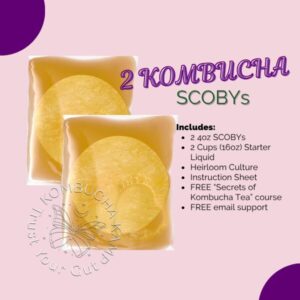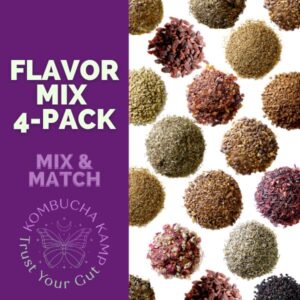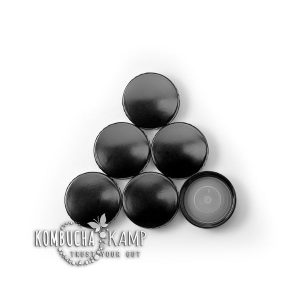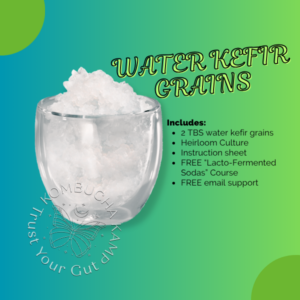
Do you want a good carbonation from your kombucha? I’m the Kombucha Mamma and I’m here to share my 7 tips for fizzy kombucha!
Kombucha Carbonation for Beginners
Kombucha is naturally fizzy. Effervescence is a natural byproduct of kombucha fermentation in which yeast creates invertase and uses it to snip glucose and fruit sugar molecules into monosaccharides. CO2 (fizz) and ethanol (alcohol) are the results of that process. In a way, ethanol acts as a preservative by protecting our craft beer against pathogens. Also, ethanol can become a food source for the bacteria. So, they consume the ethanol and convert it into healthy acids, leaving only a tiny amount of alcohol. Finally, ethanol is medicinal in small doses. Therefore, you are able to reap all of the benefits of the booch more easily.
Shop the article - notice we don't have any annoying Pop-Ups? Buy Kombucha Kamp products to support our small family business!
-

Root Beer Flavoring Pack of 4
Rated 4.97 out of 5$27.95 Add to cart -
Sale!

Ferment Friend Heater with Thermostat Control
Rated 4.98 out of 5$179.95Original price was: $179.95.$149.95Current price is: $149.95. Add to cart -

Tea Saver Pack of 4 – Loose Flavored Tea Packets
Rated 5.00 out of 5$39.95 — or subscribe to save up to 5% Select options -
Sale!

Jun SCOBY Culture
Rated 5.00 out of 5$44.88 – $69.88Price range: $44.88 through $69.88 Select options This product has multiple variants. The options may be chosen on the product page -

Replacement GT Synergy/KeVita Kombucha Bottle Caps
Rated 4.97 out of 5$7.95 – $12.95Price range: $7.95 through $12.95 Select options This product has multiple variants. The options may be chosen on the product page -

Water Kefir Grains
Rated 4.99 out of 5$24.88 – $79.88Price range: $24.88 through $79.88 Select options This product has multiple variants. The options may be chosen on the product page -
Sale!

Fresh Kombucha SCOBYs – 2 Kombucha SCOBY Cultures
Rated 5.00 out of 5$77.66Original price was: $77.66.$44.88Current price is: $44.88. Add to cart -

Flavor Saver – Pack of 4
Rated 4.99 out of 5$17.95 Select options
7 Tips for Fizzy kombucha
Tip #1 - Temperature Matters!
Add Heat During Primary Fermentation. Several studies suggest that Kombucha has a specific temperature range – around 25° Celsius or 77° Fahrenheit. That’s when we see the best production of acetic acid (the dominant acid in Kombucha). For this reason, we say the ideal temperature range for your Kombucha is 75-85°F.
Tip #2 - Tight Caps for Bottles
You must have a tight cap for your bottles or container. Reusing commercial Kombucha bottles is a great idea to start, but over time the caps can wear out. Using Replacement Caps or sourcing better bottles for ferments such as flip-tops will improve carbonation as well since these will seal in the carbon dioxide more effectively.
Tip #3 - Sugar + yeast = fizz!
Sugar is what sparks yeast, and the yeast are responsible for the bubbles. 1/2 teaspoon of straight cane sugar per 16oz bottle should crank up the Kombucha carbonation. Ginger can also have a strong effect. Even flowers such as elderflower have natural yeast that can boost the bubbles. Fruit and juice do the same, especially pureed fruit which really fires up the fizz. Be careful and burp your bottles to prevent explosions!
Tip #4 - Stir Prior to Decanting
Distributing the yeast evenly throughout the Kombucha prior to dispensing it into the bottles ensures that each bottle has a chance to be just as fizzy as the next. If we pour and then dump the yeast into one bottle at the end, the result is 4 flat bottles and one super fizzy one that ends up redecorating the ceiling – oops!
Tip #5 - Minimize Headspace
Leaving just a centimeter or so of space at the top off the bottle forces more carbon dioxide to remain dissolved in the liquid, making it less likely to escape through the bottle seal.
Tip #6 - Leave Bottles Out of the Fridge
Leave the bottles at room temperature to continue building carbonation, especially if you are checking the bottles and no bubbles are happening yet. 1-2 hours at room temperature is often enough to “re-awaken” the brew after refrigeration. The cold liquid stores more CO2, so as it warms up, the bubbles are released and ready to rumba.
Tip #7 - Nestle Bottles Against a Heat Source
Add a heater to the second ferment to boost fermentation and CO2. Cold conditions reduce the activity of the yeast. Also, colder liquid can hold more CO2, but when warmed the bubbles are pushed to leave the liquid. As always, check to make sure you don’t overcarbonate the brews by burping your bottles regularly.
I hope these videos encourage you to try carbonating your Kombucha if you haven’t before. Once you fall in love (and I know you will) – then come learn to make your own Kombucha with a free recipe and illustrated DIY Guide on KombuchaKamp
Timestamps
- 0:41 Check out the difference between “forced” bubbles and natural bubbles
- 1:09 Ethanol? Will Kombucha get me drunk?
- 2:49 How to keep your Kombucha warm and cozy in the winter
- 3:51 How to Bottle your ‘Buch
- 4:40 Hold up, I want to know how to flavor my Kombucha NOW
- 7:43 What if my Kombucha OVERcarbonates?
- 9:20 Kombucha cuddles
- 10:25 Kits, Cultures, and Supplies – Oh My!













Reinier Barcalado
July 26, 2025 at 9:29 amBedankt voor de handige tips, Hannah! Erg inspirerend, ik ben van plan om binnenkort zelf kombucha te gaan maken, voor het eerst.
Eén vraagje: hoeveel druk moeten de flessen eigenlijk aankunnen bij de tweede fermentatie? Ik kwam deze glazen beugelflessen tegen:
Denk je dat deze geschikt zouden zijn voor een bruisende kombucha?
Nogmaals dank voor alle nuttige informatie!
Translation:
Thank you for the helpful tips, Hannah! Very inspiring—I’m planning to start making kombucha myself soon, for the first time.
One quick question: how much pressure should the bottles be able to handle during the second fermentation? I came across these glass swing-top bottles:
https://beugelflessen-kopen.nl/product/glazen-beugelfles-750ml-075-liter/
Do you think these would be suitable for a fizzy kombucha?
Thanks again for all the useful information!
kombuchaoffice@gmail.com
July 28, 2025 at 4:37 pmBedankt voor je leuke reactie! Ja, die flessen lijken geschikt—zorg er wel voor dat ze drukbestendig zijn. Veel succes met je eerste brouwsel!
English:
Thanks for your kind comment! Yes, those bottles look suitable—just make sure they’re pressure-resistant. Best of luck with your first brew!
Mel
May 16, 2023 at 8:32 pmGrapes, cut in half during the second fermentation. And smaller 2nd fermentation vessels.